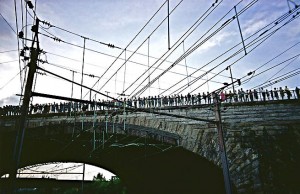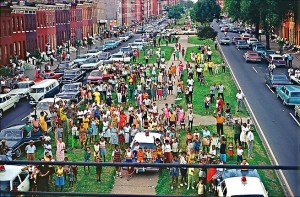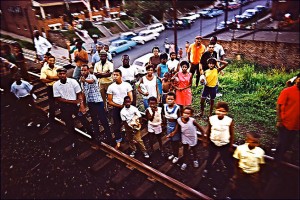thanks to Rofey for putting us on to this;
RFK FUNERAL TRAIN REDISCOVERED
an exhibition at The Danziger Project, New York, September 4 – October 4, 2008
On June 5th, 1968, less than three months after the murder of the civil rights leader Martin Luther King, Robert Kennedy was assassinated in Los Angeles as he was campaigning for the Presidential nomination. His death shook the country to its core. To Paul Fusco and millions of other Americans it seemed to represent the end of hope.
Kennedy’s body was subsequently flown to New York City for a memorial service at St. Patrick’s Cathedral and then carried by train from New York to Washington D.C. for burial at Arlington. That final journey took place on June 8th – a swelteringly hot early summer day. On board the train was the Magnum photographer Paul Fusco, then a young photographer on assignment for LOOK Magazine. As the train made its progress down the eastern seaboard, hundreds of thousands of mourners came out to line the railway tracks and pay their final respects to Bobby Kennedy and all he stood for.
From inside the train, Fusco began to take pictures of the mourners – people from every section of society – black, white, rich, poor, in large groups and on their own. By Fusco’s own calculation, he took approximately 2,000 pictures in the eight hours it took for the train to make the usually four-hour journey.
The resulting images are one of the most powerful and affecting series of photographs ever taken. Shot on Kodachrome film – a film with a particularly vibrant palette favored at the time by photojournalists – Fusco’s pictures blend the spontaneous look of snapshots with artistic precision of the decisive moment. Each photograph carries its own weight and tells its own story, but cumulatively the series is an epic vision of American dreams dashed and the indomitability of the American spirit.
Because LOOK Magazine’s bi-weekly schedule caused it to come out a week after its rival LIFE, the magazine chose to print a retrospective album of pictures of RFK rather than pictures of the funeral, and so Fusco’s RFK Funeral Train photographs were relegated to the picture files. Three years later, LOOK magazine folded. Unlike LIFE, there was no infrastructure to promote or exhibit work from the archive (just as interest in the medium of photography was exploding). Fusco managed to hold on to less than two hundred of his pictures, but the rest were folded into a collection of approximately five million pictures donated by LOOK to the Library of Congress.
The photographs would have remained an editorial footnote, were it not for the efforts of Natasha Lunn, a young photo editor at Magnum, who was shown the work in 1998 and passed them on to GEORGE magazine who published the pictures to coincide with the 30th anniversary of the RFK’s death. The rediscovery had begun.
The pictures were subsequently exhibited at The Photographers’ Gallery in London in November 1999, and with the support of Xerox, a limited edition of 300 books were published to showcase Xerox’s print on demand technology. A year later the book was reprinted as a trade hardcover with a print run of 2000, but that edition has been out of print for many years.
As director of Magnum New York in 2003 – 2004, getting to know Paul was one of the many privileges of the position. Housing the work of legendary photographers like Capa and Cartier-Bresson, the depth and quality of the Magnum archive is legendary. Yet for me, nothing was more affecting than Fusco’s RFK Funeral Train pictures.
When I opened Danziger Projects in 2005, I was determined to find a fresh way to show the work and a year later, I began the process of looking at all the pictures taken on that day that Paul had in his possession. While the original book edit of 53 pictures was indeed a strong one, there were extraordinary unseen images and I proposed doing a show that mixed the greatest published and unpublished photographs into one key set.
Shortly thereafter I showed a selection of these images to Lesley Martin at Aperture and suggested that as the book was out of print, republishing a new edition might be a worthwhile project. She agreed and as Aperture’s new book was nearing finalization Lesley located the over 1800 unseen pictures at the Library of Congress. This group yielded even more treasures and the set of pictures we are now exhibiting ultimately consists of pictures from the original book, unpublished pictures from the Magnum archive, and the re-discovered pictures from the Library of Congress. (Aperture’s book will now be published August 2008.)
After experimenting with many different papers and processes, we selected Cibachrome paper for the brilliance of its color and its proven longevity. The prints were made by Esteban Mauchi at Laumont Labs in New York, who worked brilliantly and dedicatedly for the full year it took to finalize the set. I would also like to thank Barbara Orbach Natanson, Head of the Reference Section of the Prints and Photographs Division at the Library of Congress whose help and enthusiasm made the continuing rediscovery process all the more significant.
Paul Fusco was born in Leominster, Massachusetts in 1930. He received his B.F.A. in photojournalism from Ohio University and went directly to work for Look magazine as a staff photographer and traveled extensively in South East Asia, Mexico, India, Europe and Russia. In 1974 he joined Magnum Photos. His work has appeared in publications such as LIFE, Time, Newsweek, The Sunday Times and Paris Match. He has exhibited at the Metropolitan Museum of Art, New York; San Francisco Museum of Modern Art; and the Corcoran Gallery, Washington, D.C.. Most recently, the Metropolitan Museum of Art in New York acquired six of the RFK Funeral Train photographs .
James Danziger. New York City, 2008.
For more information on the exhibition, please e-mail info@danzigerprojects.com or call 212 629 6778.


